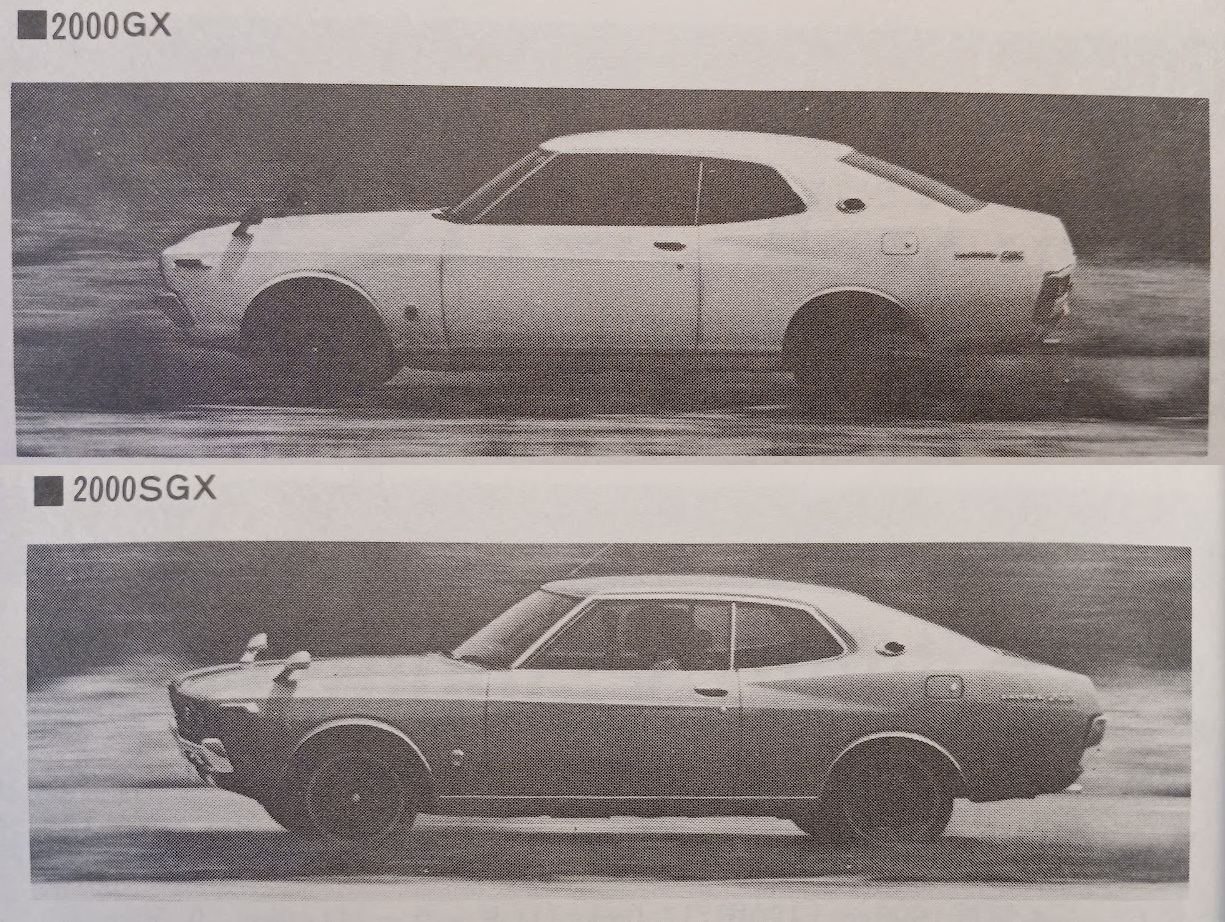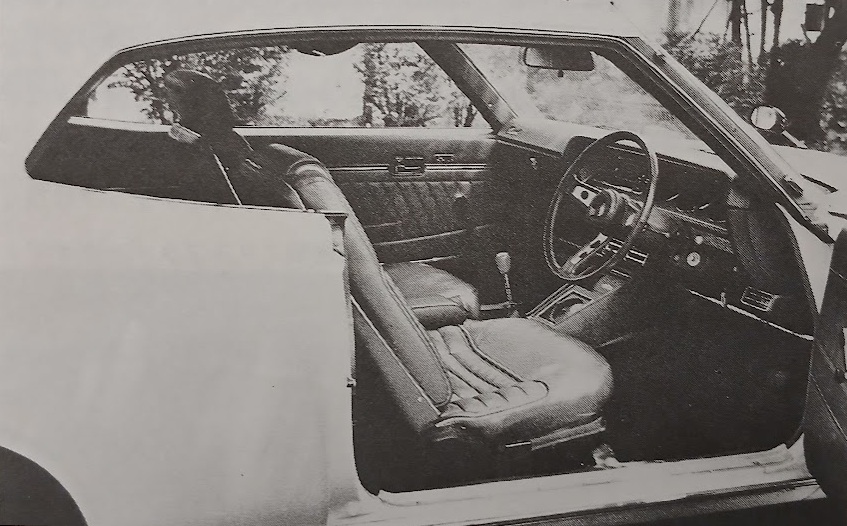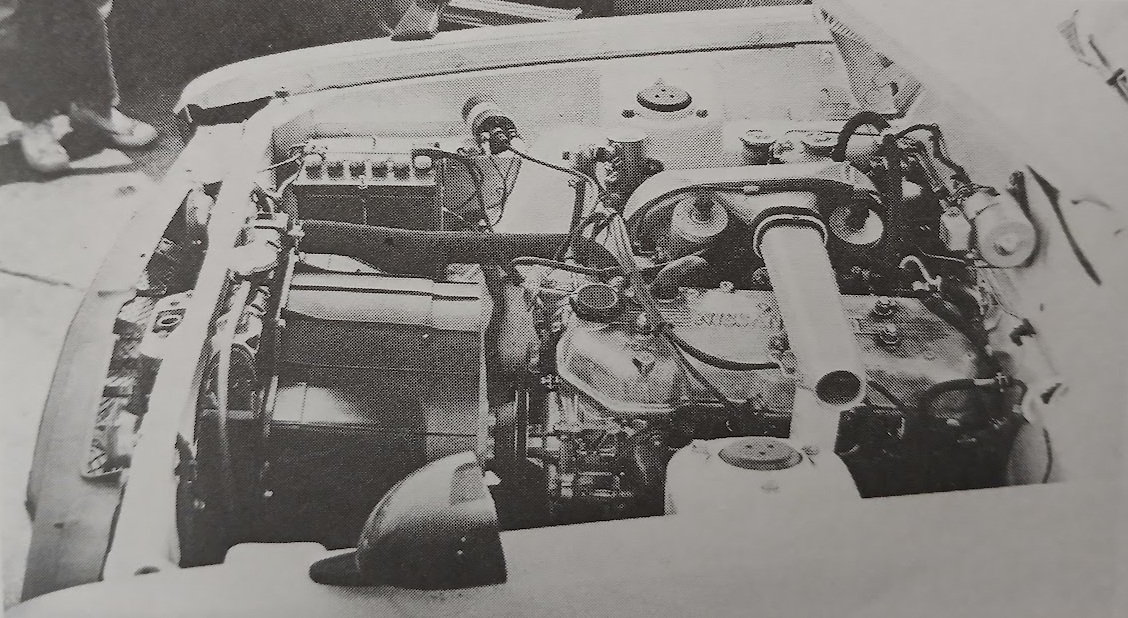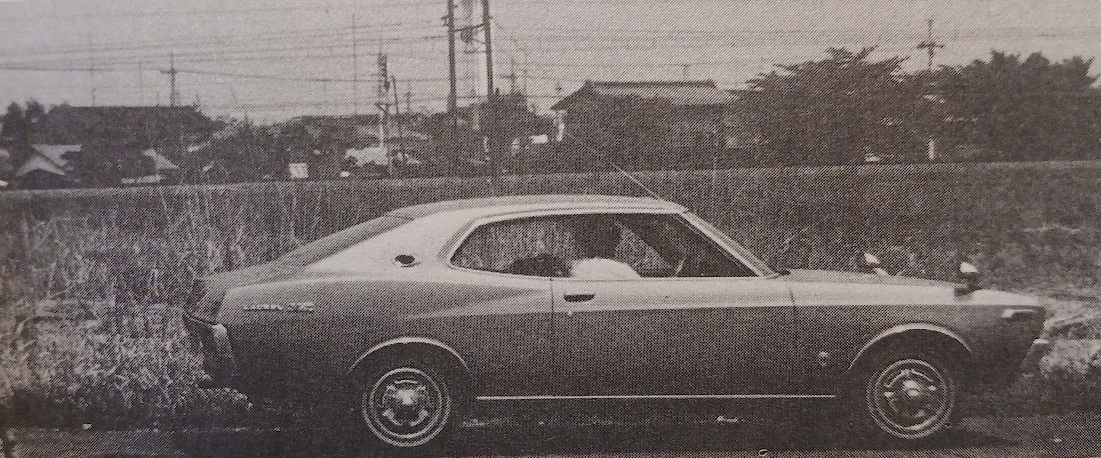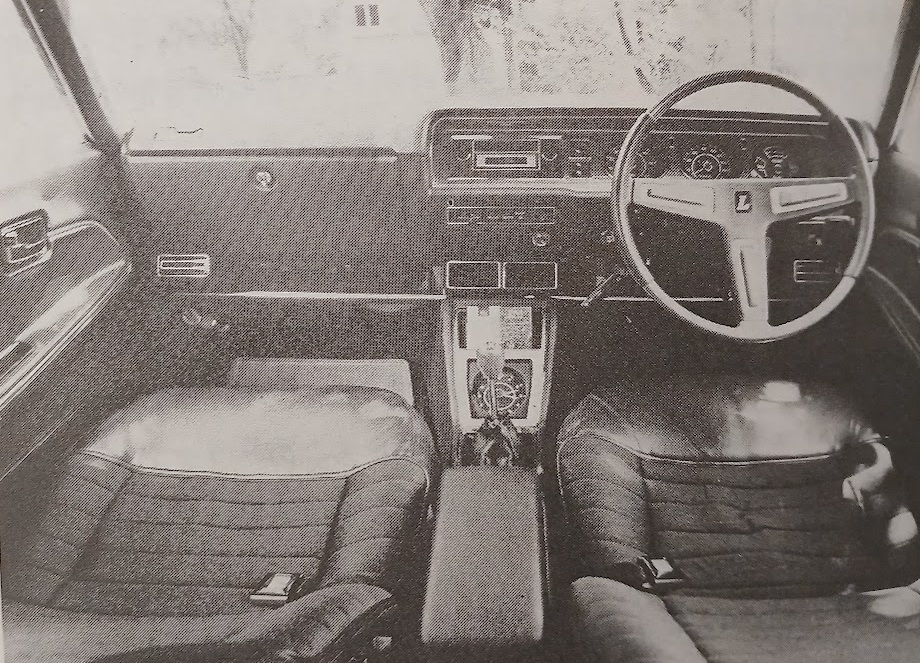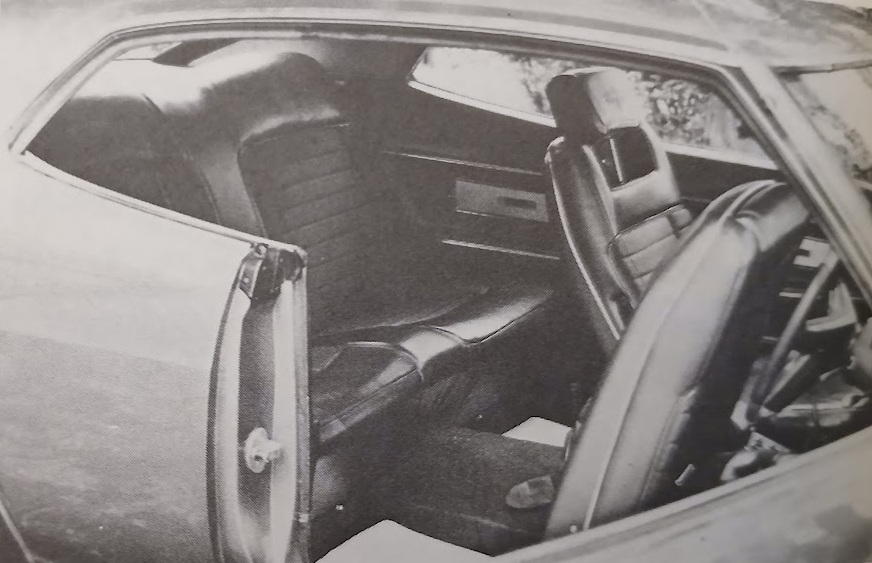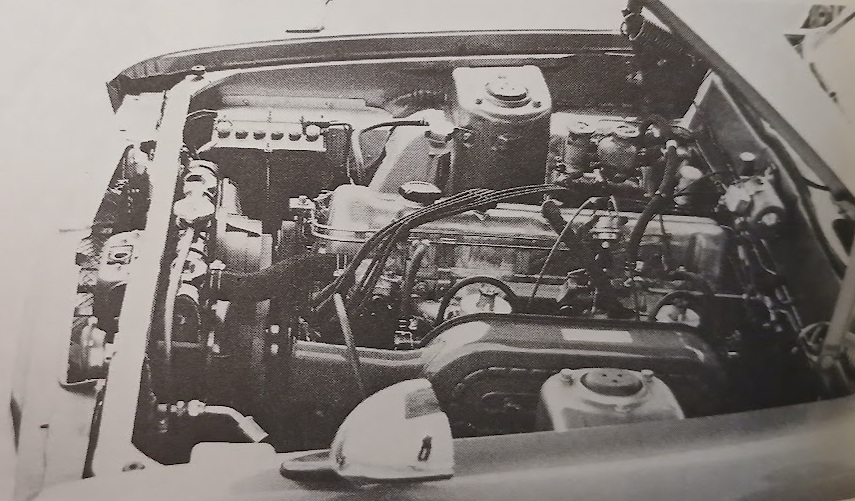Nissan Laurel 2000GX and 2000SGX Hardtops (1972)
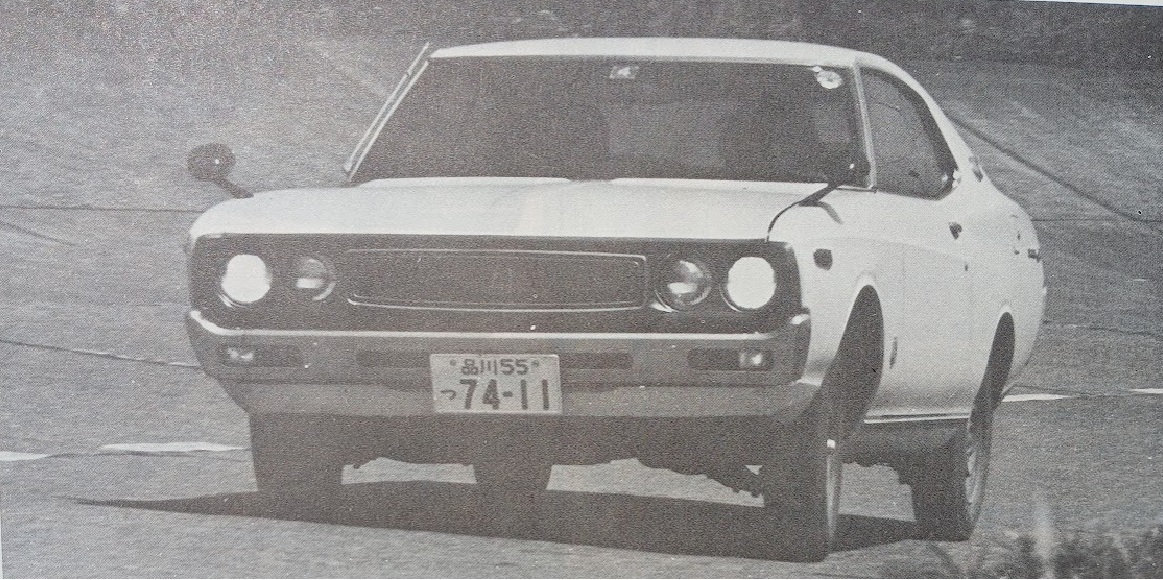
Publication: Car Graphic
Format: Road Impressions
Date: July 1972
Author: “C/G Test Group” (uncredited)
Road testing the Nissan Laurel 2000GX and 2000SGX Hardtops
The Nissan Laurel, a pioneer of intermediate cars in Japan, underwent its first full model change on April 4th, following in the footsteps of its rival, the Corona Mark II. As a result, the Laurel received a larger, newly designed body that is closer in size to the Cedric. In addition to the previous G18/G20 four-cylinder engines, the series now also includes the L20 six-cylinder engine found in the Cedric/Gloria, Skyline GT, and Fairlady Z. The body is available in four-door sedan and two-door hardtop configurations. The hardtops retain the previous four-wheel independent suspension with MacPherson struts and coil springs in the front and semi-trailing arms and coil springs in the rear, while the sedans changed the rear suspension to a rigid leaf spring type (a step backward?).
Our test models were the sportiest versions of the four-cylinder and six-cylinder hardtops, the 2000GX (four-cylinder) and 2000SGX (six-cylinder), as well as the top-of-the-line sedan, the 2000SGL (published separately).
The 2000GX’s G20 twin-carb engine is an improved version of the SOHC four-cylinder 1.5-liter engine that Prince developed for the Skyline. With a displacement of 1990cc (89x80mm), it has a compression ratio of 8.3 (9.7 for high-octane models) and two Hitachi SU carburetors, resulting in an output of 120ps/5800rpm and17.0kgm/3600rpm (125ps and 17.5kgm in the high-octane gasoline version). The test car was a regular-octane 120ps model with the standard 4-speed fully-synchronized floor-shift gearbox (a 5-speed gearbox is optional for an extra 20,000 yen, and an automatic is a 55,000 yen option). The Tokyo retail price was 895,000 yen, the body was white, and the interior was a dark camel color.
On the other hand, the 2000SGX’s L20 twin-carb six-cylinder SOHC engine is in the same state of tune as the Skyline 2000GT-X, with a displacement of 1998cc (78x70mm), a compression ratio of 8.6, and two Hitachi SU carburetors, giving it 125ps/6000rpm and 17.0kgm/4400rpm (the high-octane gasoline version has a compression ratio of 9.5,130ps, and 17.5kgm). The test car was a regular-octane 125ps model with the optional 5-speed fully-synchronized floor-shift gearbox, and also had a cooler (an option that costs an additional 140,000 yen). The standard price of the 4-speed model is 1,030,000 yen, so the test car cost a whopping 1,190,000 yen (!). The color scheme was metallic green, both inside and out.
Before setting off, let’s compare the interior and exterior of both cars. Both have high-grade cross-ply tires, Bridgestone Super Speed 2s, but those on the GX have black sidewalls while the SGX’s have double white ribbons. The wheel arches on the SGX are decorated with plated trim, and the bullet-shaped mirrors are black on the GX and chrome on the SGX. Looking at the interior, only the GX has a sports-type-design steering wheel with metal perforated spokes, the seats are vinyl on the GX and cloth on the SGX, and only the SGX has power windows. According to the catalog, the maximum speed of both cars is 175km/h (180km/h for the high-octane 5-speed SGX), but it seems that the manufacturer has given the four-cylinder GX a sportier character. And when we actually drove both cars, they showed exactly that character.
Comparing the power-to-weight ratios of the two vehicles, the GX is slightly better (GX: four-cylinder, 1990cc, 120ps/17.0kgm, 1140kg, 9.50kg/ps; SGX: six-cylinder, 1998cc, 125ps/17.0kgm, 1205kg, 9.64kg/ps). However, once we started driving, we immediately felt that the gap was even bigger than the numerical difference. While the GX’s four-cylinder engine was powerful and lively enough for its large body, the SGX’s six-cylinder engine didn’t seem to have the same torque. The throttle response was sluggish, as if the flywheel was abnormally heavy. Simply put, it was a “sleepy engine.” This was also confirmed by acceleration tests at Murayama. The GX covered the 0-400m distance in 18.2 seconds, while the SGX took 19.1 seconds (though the SGX was slightly handicapped in weight due to the air conditioner mentioned above).
Part of the reason the SGX was slower was due to the difference in the gearbox. The GX’s 4-speed is light and reliable, and compared to the old Laurel, the lever is shorter, so the stroke is much shorter and shifts are quicker. On the other hand, the SGX’s 5-speed has powerful synchronization, like the 4-speed, but its action is heavy and the engagement position is uncertain, so shifts must be made carefully, losing fractions of a second.
Both of these gearboxes are the same as those used in the Skyline GT, and the 4-speed (3.592 / 2.246 / 1.415 / 1.000) has a final drive ratio of 3.90, the same as the Skyline, but the 5-speed (3.321 / 2.077 / 1.308 / 1.000 / 0.864) has been lowered to 4.11, so it is not as high-geared as the Skyline, and when revved up to 6300rpm, where the red zone begins (it is the same rpm for both cars), the GX reaches 53km/h in first gear, 85km/h in second, and 140km/h in third, while the SGX reaches 55km/h in first, 87km/h in second, 143km/h in third. In the lower three gears, the gearing is almost identical, so the difference in acceleration performance can be attributed primarily to the difference in engine power.
Both engines offer excellent flexibility. First of all, the GX accelerates reliably from a walking pace in second gear, from 30km/h in third gear, and from 40km/h in fourth gear, albeit with a slight vibration (which completely smooths out from just under 50km/h). On the other hand, the SGX can also be used in second gear as long as it’s moving, and accelerates slowly but effectively from 20km/h in third gear, from 30km/h in fourth gear, and even from 40km/h in overdrive fifth gear.
While both engines have sufficient flexibility, the GX undoubtedly has stronger torque overall and more punch, as reflected in the results of the overtaking acceleration tests. Comparing the 40-80km/h and 60-100km/h times in each gear, the GX’s times were 7.4 and 7.5 seconds, respectively, in third gear, and 11.5 and 11.0 seconds in fourth. The SGX, meanwhile, was 8.7 and 8.6 seconds in third, 13.1 seconds for both speed ranges in fourth, and 16.2 and 16.6 seconds in fifth. Not only is there almost no difference between the higher and lower speed ranges, the SGX is actually faster in the lower speed range in fifth, but the absolute times for the GX are still shorter. Also, in contrast to the four-cylinder engine, the six-cylinder has some detonation when you apply strong throttle from low speeds in a high gear.
Both engines really start to pick up power from 3000rpm onwards, and for a domestically produced 2-liter unit, they rev relatively smoothly all the way to the 6300rpm redline (though both vibrate a bit above 5500rpm), though the four-cylinder is more powerful at higher revs, while the six-cylinder’s rev counter rises more slowly near the top end.
Although the six-cylinder engine is inferior in all aspects of power performance, it is clearly superior in terms of noise. The four-cylinder unit is powerful, but it also produces a rather gruff sound (though it’s by no means unpleasant). According to the rather optimistic speedometer, 100km/h (actually 94km/h) is reached at just under 3300rpm in fourth gear for the GX, 3400rpm in fourth gear for the SGX, and 3000rpm in fifth gear for the SGX. However, because this six-cylinder engine is inherently quiet, there’s no need to shift up to fifth gear, which produces a slight humming sound, in terms of noise. Moreover, as mentioned above, it’s very flexible, eliminating the need to frequently shift gears, so the five-speed gearbox is probably unnecessary for the six-cylinder; the four-speed is sufficient. On the other hand, the lively four-cylinder and 5-speed is probably a more valuable combination than it is with the six-cylinder. If the law and circumstances permit, these two Laurels are able to continue running comfortably up to 130-140km/h, making them ideal as high-speed cruisers for four people.
As for maneuverability, simply put, the new Laurel handles not only significantly better than the previous model, but also better than its rival, the Corona Mark II, and its sibling, the sleek Skyline GT. This is due to the synergistic effects of the steering, which has been changed from a rack-and-pinion to a recirculating-ball type and is now much more rigid and precise than expected, the wider wheelbase and tread (old model, 2620mm and 1315/1310mm; new model, 2670mm and 1350/1330mm), and the suspension, which has been modified and strengthened to the point that parts are almost incompatible despite being the same format as the old model. The handling characteristics are stable, with not-too-strong understeer, and although the tail eventually starts to slide, the slide is never sudden and feels safe. This is partly due to the high-speed cross-ply tires, Bridgestone Super Speed 2 6.45S-14s (on 4.5J rims), which don’t offer as much grip as radials, but provide a smoother slide.
The heavier, larger L20 six-cylinder engine also negatively affects steering. That is, while the steering effort of the four-cylinder GX is just right, that of the SGX is heavy and unresponsive. However, the damping force of the front dampers and the spring constants of the coil springs are different between the six-cylinder and four-cylinder models, with the six-cylinder’s being stronger, so contrary to expectations, the amount of understeer in both cars was almost the same. (The recommended high-speed air pressures were also distributed differently front and rear, 1.9/2.0kg/cm² for the four-cylinder, and 1.9/1.9kg/cm² for the six-cylinder – 2.0/2.0 with the cooler.)
The ride is excellent regardless of the road surface, and thanks to the four-wheel independent suspension, you can even tackle rough, unpaved roads at high speeds. The stronger dampers and superior seats compared to the previous model also help, but the Bridgestone Super Speed 2 is a stiff tire for a cross-ply, so road noise is a bit conspicuous.
The brakes are power-assisted discs/drums, equipped with a master cylinder and a proportioning valve to prevent the rear wheels from locking. The braking force is not particularly strong, and when braking fully from 50km/h with a pedal force of 40-50kg, the GX’s stopping distance is 10.5m, and the SGX’s is 11.7m. However, the brakes are effective at high speeds and are highly reliable.
The interior is as luxurious as the Toyota Mark II, offering everything you’d expect from a Japanese car in this class, including effective ventilation. The dashboard design, with panels sloping down and forward, is unique and characteristic of Nissan, yet has a pleasing lack of unnecessary ornamentation. The wiper (left) and light (right) switches, located on stalks on the steering column, are clearly easier to operate than those on the Mark II (more on the excellent wiper functionality in our report on the sedan).
The driving position, lower than that of the previous Laurel, is excellent, and the seat is generously sized and comfortable, with substantial lumbar support despite its appearance. The pedals are well-placed, allowing for heel-and-toe driving, and there’s enough space for the left foot. However, the handbrake is still an umbrella-handle type under the dash, making it difficult to use, and the return spring for the automatic seatbelt retractor is too strong, making it tempting to immediately unfasten the belt unless you see the warning light, which can be dangerous.
Another big problem is poor rear visibility. This is not limited to the Laurel, and can be said of all recent cars with semi-fastback rooflines, but it is particularly true in the Laurel, where the lower edge of the window is very high and the rear seat headrests protrude significantly, making it extremely difficult to reverse into a garage, as ends of the rear fenders are impossible to see.
We have attempted to quantify this. A typical driver, about 170cm tall, turns around from the driver’s seat and looks back through the window. We measure the point from the rear bumper where the top of a 60cm-high camera ladder begins to appear in the driver’s vision. The results showed that the Laurel has a blind spot that reaches approximately 6m back. In other words, if a child under 60cm tall is within 6m of the rear of the car, the driver will not be able to see them at all, which is extremely dangerous. When we performed the same measurements on the C/G Cherry Van and an editor’s Morris 1100, we could see the ladder in the former car from about 3m away, half the distance of the Laurel, and the latter was even shorter, at just under 2m, so we believe designers who are only concerned with appearances when it comes to styling (although whether this styling is even a plus point is highly questionable) should seriously reflect on this point.
Finally, regarding fuel economy, we drove in a variety of conditions without much regard for fuel economy, including in crowded city streets (which took up the majority of our testing time), commuting from the suburbs, and performance testing at Murayama. The results were that the GX with 4-speed gearbox consumed 59.1 liters over 382km, for a total of 6.46km/l, while the SGX with 5-speed consumed 68.4 liters over 356km, for a total of 5.20km/l. This shows that the six-cylinder engine, even with a 5-speed gearbox, is inferior to the four-cylinder engine in terms of fuel economy (both on regular gasoline).
The new Laurel, with its BMW-style European mechanicals wrapped up in an American-style body, is an improvement over the previous Laurel, which had a BMW-like body as well as mechanicals. Other than the styling, it can be said to have improved in almost every respect, including body rigidity, interior and exterior finish, handling, and ride comfort. However, the heavy, large, and “sleepy” six-cylinder L20 engine clearly spoils the car’s relatively nimble character. Unless you’re willing to spend an extra 100,000 yen to “drive slowly,” as the advertisements say, and have even the slightest desire to drive a Laurel that is faster and more economical, you should definitely choose the four-cylinder. Even then, unless you regularly cruise on the highway, the 4-speed gearbox would be a better choice than the heavy-shifting 5-speed.
Postscript: Story Photos
